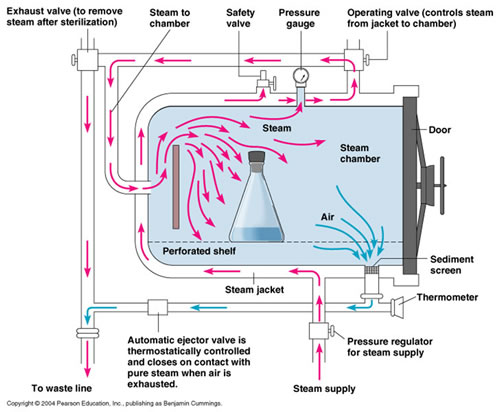Autoclaves
Locations: 3159 MRB 3, 4159 MRB 3, and CC-2302 MCN
This is an excellent overview of autoclave operation posted by Dr. Howard Judelson at UC Riverside. The specifics of their machines are different than ours, so ignore the instructions at the end.
A note about media in autoclave trays & downward displacement autoclaves

Our autoclaves are downward displacement models. They work by forcing steam in at the side or back of the chamber which displaces the air downwards and out through a grated drain. There is turbulence inside the chamber (the steam comes in at about 25 p.s.i.) but solid walled trays can create a tub of air which prevents steam from contacting the entire surface area of the bottles. This means they are not exchanging heat properly and the media may not reach sterilizing temperatures.
Trays with holes would do a better job of reaching sterilizing temperature (Gillespie & Gibbons, 1975), but trays are help with user safety and for keeping the machines in good working order. About a quarter of autoclave trouble calls are due to clogged drains according to the SER shop, sometimes because of agar media, sometimes because of melted trays, sometimes just built up detritus. So trays keep the machines running well by preventing clogs; removing one tray with 16 flasks is much safer than directly handling these bottles of hot, scalding fluids individually; also, in the very unlikely event that the flasks explode, the walls of the tray provide you with some shielding. In the end, your safety is much more important than the sterility of your media so I encourage use of trays.
Recommended practices:
Below is what I consider an “aspirational” list of safety precautions. For example, rarely does one see an autoclave user wearing a rubber apron. However, these safety tips point to the very real dangers that high temperature liquids pose to users and great caution should always be exercised while unloading an autoclave.
- Before using the autoclave, check inside the autoclave for any items left by the previous user that could pose a hazard (e.g. sharps).
- Clean the drain strainer before loading the autoclave.
- Load the autoclave properly as per the manufacturer’s recommendations (do not heap).
- To prevent bottles from shattering during pressurization, the caps of containers with liquids must be loosened before loading.
- Use a POLYPROPYLENE (PP) tray with a solid bottom and walls to contain the contents and catch spills.
- Add 1/4 to 1/2 inch of water to the tray so the bottles will heat evenly during liquid cycles.
- Check plastic materials to ensure they are compatible with the autoclave (no LDPE marked items).
- Individual glassware pieces should be within a heat resistant plastic tray on a shelf or rack and never placed directly on the autoclave bottom or floor.
- Make sure the door of the autoclave is fully closed (latched) and the correct cycle has been selected before starting the cycle (temperature should be 121°C).
- Wear heat-resistant gloves when opening the autoclave door after a cycle. If there is a sharps hazard (e.g. biological waste), wear heat AND cut resistant gloves.
- Before removing autoclaved items, wait 5 minutes for loads containing only dry glassware, and 10 minutes for autoclaved liquid loads.
- At a minimum, when removing items from an autoclave, a rubber apron, rubber sleeve protectors and heat-resistant gloves should be worn.
- For non-liquid loads, let the glassware cool for 15 minutes before touching it with bare hands.
- For liquid loads, let liquids stand for a full hour before touching with ungloved hands. Be sure others in the area know a heat hazard is present.